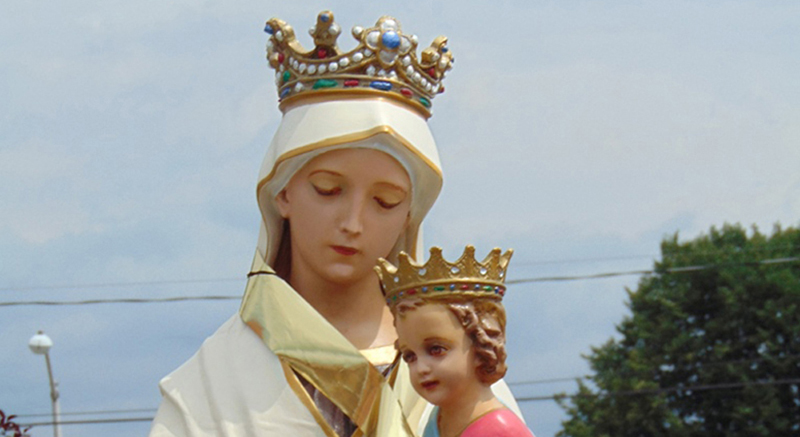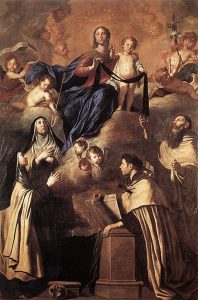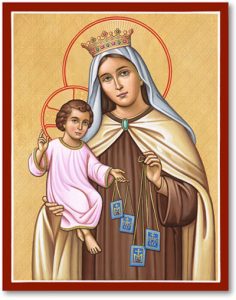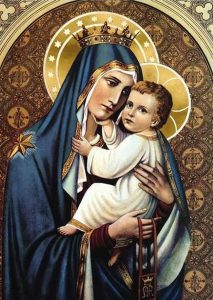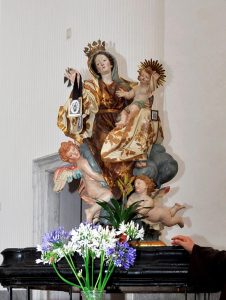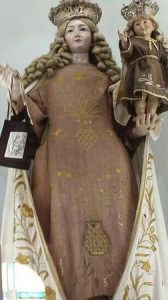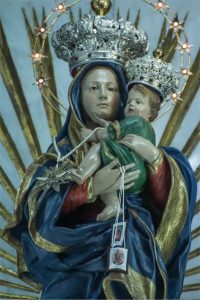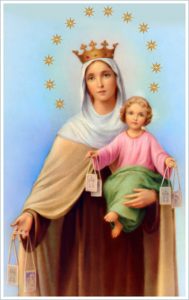Our Lady of Mount Carmel (Pietro Novelli, 1641)
“All Are Welcome”
(Haugen)
This song has been used to celebrate our parish anniversaries and major feastdays, and always for the weekend of our parish festival and the Feast of Our Lady of Mount Carmel.
Our Lady of Mount Carmel — Title and feast day
Our Lady of Mount Carmel is the title given to the Blessed Virgin Mary in her role as patroness of the Carmelite Order. The first Carmelites were Christian hermits living on Mount Carmel in the Holy Land during the late 12th and early to mid 13th century. They built among their hermitages a chapel which they dedicated to the Blessed Virgin, whom they conceived of in chivalric terms as the “Lady of the Place.”
The liturgical feast of Our Lady of Mount Carmel is celebrated on July 16. The solemn liturgical feast of Our Lady of Mount Carmel probably was first celebrated in England in the later part of the 14th century. Its object was thanksgiving to Mary, the patroness of the Carmelite Order (“Brothers of the Virgin Mary”) for the benefits she had accorded to the order through its difficult early years.
The date chosen was July 17; on the European mainland this date conflicted with the feast of St. Alexis, requiring a shift to July 15, which remains the Feast of Our Lady of Mount Carmel throughout the Catholic Church. The Latin poem “Flos Carmeli” (meaning “Flower of Carmel”) first appears as the sequence for this Mass.
The Carmelite Order and the scapular
The Carmelite Order was the only religious order to be started in the Crusader States. In the 13th century, some of its people migrated west to England, setting up a chapter there in 1241. A tradition first attested to in the late 14th century says that St. Simon Stock (1165-1265), believed to be an early English prior general of the Carmelite Order soon after its migration to England, had a vision of the Blessed Virgin Mary in which she gave him the Brown Scapular. This scapular formed part of the Carmelite habit after 1287.
In St. Simon Stock’s vision, Mary promised that those who died wearing the scapular would be saved. This is a devotional sacramental signifying the wearer’s consecration to Mary and affiliation with the Carmelite order. It symbolizes her special protection and calls the wearers to consecrate themselves to her in a special way.
The liturgical feast of Our Lady of Mount Carmel did not originally have a specific association with the Brown Scapular or the tradition of Stock’s vision of the Blessed Virgin Mary. This tradition grew gradually, as did the liturgical cult of St. Simon. Since the 15th century, popular devotion to Our Lady of Mount Carmel has centered on the Scapular of Our Lady of Mount Carmel, also known as the Brown Scapular.
Our Lady of Mount Carmel in Spain and Spanish-speaking countries
In Spain and other Spanish-speaking countries, there has been particular devotion to Our Lady of Mount Carmel, who has been adopted as a patron saint of several places, as she has been in other Catholic-majority countries.
In addition, Carmen and María del Carmen have been popular given names for girls in Spanish-speaking countries. An annual festival, known as Mamacha Carmen, takes place in the highland Paucartambo District, Peru, featuring a procession with the Virgin and traditional dancers. Veneration of the Virgen del Carmen (often also associated with the Stella Maris — Star of the Sea) is particularly strong in coastal towns of Spain. Our Lady of Mount Carmel was adopted in the 19th century as the patron saint of Chile, in South America.
What does Devotion to Our Lady of Mount Carmel mean?
The Carmelites consider the Blessed Virgin Mary to be a perfect model of the interior life of prayer and contemplation to which Carmelites aspire, as well as a model of virtue, in the person who was closest in life to Jesus Christ.
She is seen as the one who points Christians most surely to Christ. As she says to the servants at the wedding at Cana, “Do whatever he (Jesus) tells you,” Carmelites look to the Virgin Mary as a Spiritual Mother. The Stella Maris Monastery on Mount Carmel, named after a traditional title of the Blessed Virgin Mary, is considered the spiritual headquarters of the order.
Devotion to Our Lady of Mount Carmel means a special call to the interior life, which is pre-eminently a Marian life. Our Lady wants us to resemble her not only in our outward vesture but, far more, in heart and spirit.
If we gaze into Mary’s soul, we shall see that grace in her has flowered into a spiritual life of incalculable wealth: a life of recollection, prayer, uninterrupted oblation to God, continual contact, and intimate union with him. Mary’s soul is a sanctuary reserved for God alone, where no human creature has ever left its trace, where love and zeal for the glory of God and the salvation of mankind reign supreme.
Those who want to live their devotion to Our Lady of Mt. Carmel to the full must follow Mary into the depths of her interior life.
Carmel is the symbol of the contemplative life, the life wholly dedicated to the quest for God, wholly orientated towards intimacy with God; and the one who has best realized this highest of ideals is Our Lady herself, “Queen and Splendor of Carmel.”
Church teaching about the scapular
A 1996 doctrinal statement approved by the Congregation for Divine Worship and the Discipline of the Sacraments states that Devotion to Our Lady of Mount Carmel is bound to the history and spiritual values of the Order of the Brothers of the Blessed Virgin Mary of Mount Carmel and is expressed through the scapular.
Thus, whoever receives the scapular becomes a member of the order and pledges him/herself to live according to its spirituality in accordance with the characteristics of his/her state in life.
The scapular is a Marian habit or garment. It is a sign and pledge — a sign of belonging to Mary; a pledge of her motherly protection, not only in this life but after death. The scapular is a conventional sign signifying three strictly joined elements:
-
Belonging to a religious family particularly devoted to Mary, especially dear to Mary, the Carmelite Order.
-
Consecration to Mary, devotion to and trust in her Immaculate Heart.
-
An urge to become like Mary by imitating her virtues, above all her humility, chastity, and spirit of prayer.
Apparitions of Our Lady of Mount Carmel
There is today a small sanctuary at Acquafondata, Italy, where the Virgin of Mount Carmel reportedly appeared on July 16, 1841. The visionaries of Our Lady of Fátima in 1917 reported Our Lady of Mount Carmel as among the titles claimed by Mary. She is said to have appeared to St. Simon Stock to whom she gave the Brown Scapular. The Garabandal apparitions in Spain (1961–65) were reported to be images of the Blessed Virgin Mary of Mount Carmel.
A miracle in Italy
In Palmi, Italy, the anniversary of the earthquake of 1894 is observed annually on Nov. 16. The earthquake had its epicenter in the city. An associated event has been classified as the “miracle of Our Lady of Mount Carmel.” For 17 days preceding this earthquake, many of the faithful had reported strange eye movements and changes in the coloring of the face in a statue of Our Lady of Mount Carmel. The local and national press reported these occurrences.
In the evening of Nov. 16, the faithful improvised a procession carrying the statue of the Virgin of Carmel on their shoulders through the streets. When the procession reached the end of the city, a violent earthquake shook the whole district of Palmi, ruining most of the old houses along the way.
But only nine people died out of a population of about 15,000 inhabitants, as almost all of the population had been on the street to watch the procession and were not trapped inside the destroyed buildings. Therefore, the city commemorates the 1894 procession each year, accompanied by firecrackers, lights, and festive stalls.
The Catholic Church officially has recognized the miracle. On Nov. 16, 1896, the statue of the Virgin was crowned, based on the decree issued Sept. 22, 1895, by the Vatican Chapter.
Movement toward peace
The first atomic bomb was exploded in the United States at the Trinity test site on July 16, 1945, near Alamogordo, New Mexico. The Catholic anti-war movement has built on the coincidence between this date and the Feast of Our Lady of Mount Carmel.
In 1990 the Rev. Emmanuel Charles McCarthy, a priest of the Eastern Rite (Byzantine-Melkite) of the Catholic Church, initiated the “16 July Twenty-Four Hours Day of Prayer,” for Forgiveness and Protection with Our Lady of Mount Carmel, at the Trinity site in the New Mexico desert. Each year on July 16, a prayer vigil is conducted at the Trinity site to pray for peace and the elimination of nuclear weapons.
Video reflection and prayer
The Story of Mary of Mount Carmel for children
Devotion to Our Lady of Mount Carmel
(Catholic News Agency)
Our Lady of Mount Carmel & the scapular
(The Rev. Fernando Flores, Cyprus)
About Our Lady of Mount Carmel?
(Sister JanineVan Tran, CMR )
Devotion to Our Lady of Carmel in Haifa
(Christian Media Center)
Our Lady of Mount Carmel
(Carmelite Brother Pier Giorgio)
Prayer to Our Lady of Mount Carmel
Seven Things You Need to Know about Our Lady of Mount Carmel
1827 Video Feast of Our Lady of Mount Carmel in London’s Little Italy
Images of Our Lady of Mount Carmel from Italy
Beata Virgine di Monte Carmelo (Loana, Italia)
La Madonna del Carmine (Squillace, Italia)
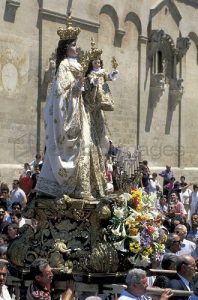
Madonna del Carmine (Avigilano, Italia)
